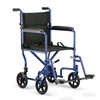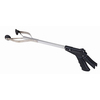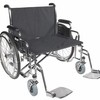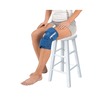A Guide To Getting Around: What To Look For When Buying A Lightweight Wheelchair
Posted on
Over the last decade, lightweight wheelchairs have revolutionized mobility, transforming lives and making freedom and independence more accessible than ever. Primarily, lightweight wheelchairs come in one of two categories—attendant (sometimes referred to as Transit wheelchairs) or self-propelled.
The Importance Of A Lightweight Wheelchair
The biggest advantage of lightweight wheelchairs comes in their portability—with frames that can be easily folded up and stored, they’re able to be transported from location to location with ease, allowing you to get out and enjoy the world on your own terms.
Beyond this a self-propelled option can achieve an even greater sense of independence, putting you firmly in control of your mobility.
This freedom also shows up in the improved manoeuvrability of a lightweight chair; with greater balance and responsiveness, a lightweight chair allows for a greater range of activities and more comfortable movement for the user.
The design of a lightweight chair also allows for a greater degree of customisation, with a variety of additional features and adjustments that can be made to ensure the chair is set up to meet your individual needs.
What You Need To Consider Before Buying A Lightweight Wheelchair
The most important thing to consider is whether you want to opt for a self-propelled light wheelchair or one that is operated by an attendant/carer. With a self-propelled option, there is a greater degree of physical exertion required, so it’s important to consider not only your own capabilities but also the types of journeys and activities you’ll be undertaking when you’re in the wheelchair.
For some people the best solution is actually to have two different wheelchairs, giving them a greater degree of flexibility.
There are a number of other additional factors to consider when deciding the right type of wheelchair for you. Starting with weight and storage capacity, as this wheelchair will be designed to be transported from location to location, it’s important to consider how you plan on transporting it and what sort of weight limitations that may bring about.
One way to minimize this issue is to buy a wheelchair with a number of detachable parts, such as footplates, arms, and wheels. The issue of weight is doubly important for transit wheelchairs, where you’ll need to consider the fact that an attendant/carer will need to be able to manage guiding it with ease.
Usage frequency should also be a factor in determining which is the right lightweight wheelchair for you.
Finally, it’s vitally important to find a chair that is comfortable for you as a user. This begins with ensuring the dimensions and fit of the chair are exactly correct, and then ask yourself, will this chair be comfortable for me to use on a regular basis? That includes ensuring that:
-
The backrest is placed high enough
-
The cushions are well-padded
-
The seating material is comfortable
-
The armrests and footplates are adjustable
Key Things To Look For When Choosing Your Lightweight Wheelchair
Now that you have some idea over the size and type of lightweight wheelchair that’s right for you it’s time to delve into exactly what you should be looking for when buying a lightweight wheelchair—starting with the wheels.
Wheels
When it comes to the wheels on your lightweight wheelchair, you’re going to be faced with a number of different options, ranging from the more expensive but light carbon fibre spokes, to the standard options of either wheel rims with spokes or a moulded plastic rim.
In terms of tyre choices, you can opt for either pneumatic or solid rubber—the pneumatic option offers greater comfort, but with an increased risk of punctures.
Footrests
When it comes to the footrest of your lightweight wheelchair you can opt for either a fixed or a removable option. Most footrests will be adjustable, allowing you to ensure your chair is set in the most comfortable position for you.
For an extra degree of user comfort, you can purchase a wheelchair with calf or heel straps attached.
The straps will help to secure your legs and make it easier for you to get out of your chair. If you’re in need of additional rest for your legs—an elevated footrest will provide a comfortable option that can keep your legs extended in front of you while you’re using the chair.
Armrests
The armrests on your chair are designed to help aid with balance and comfort—by resting your arms you help to preserve your core stability.
In terms of your armrest, options range from those that are fully removable to those that pivot out of the way once tipped up, the latter being exceptionally useful for helping you transfer in and out of the wheelchair.
In terms of length, you can opt for the full length or a half-length rest. The shorter length is designed specifically for use when the wheelchair is positioned by a table or other surface—ideal if you plan on carrying out tasks such as eating or reading when in your wheelchair.
Brakes
The brakes are one of the most important features on your wheelchair—essential for both safety and manoeuvrability.
Typically the brakes will be located just below the armrest, making them easy to reach for most users. If you’re opting for a transit wheelchair, the brakes will be located closer to the push handles.
The main thing to look out for when it comes to the brakes of your wheelchair is wear and tear—as the tyres degrade the brakes will become less efficient—to compensate for this, make sure you buy a wheelchair with an adjustment mechanism to compensate, instructions for which should be in your user manual.
The most important thing to ensure when buying is a lightweight wheelchair is that you choose a high-quality design from a reputable supplier—Island Mediquip is Vancouver Island's premier supplier of mobility aids and home medical equipment. To find the right wheelchair for you, browse our extensive collection today.


















